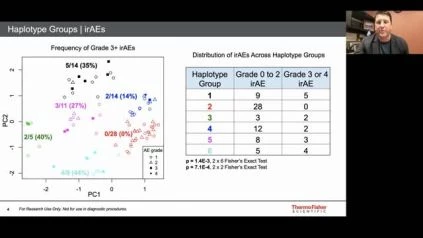Geoffrey M. Lowman, Ph.D. from Thermo Fisher Scientific discusses Haplotype Analysis of the T-Cell Receptor Beta (TCRB) Locus by Long-amplicon TCRB Repertoire Sequencing.
For more information on –
OncomineTM TCR Beta-LR Assay –
https://www.thermofisher.com/order/catalog/product/A35386?us&en#/A35386?us&en
Instract
Context:
As a risk factor for autoimmune disorders and immune-related adverse effects (IRAEs) during immunotherapy, polymorphism within the human T-cell receptor beta variable (TRBV) gene has been suggested. The repetitive nature of the T-cell receptor beta (TCRB) locus has hindered previous attempts to test TRBV polymorphism through whole genome sequencing. To allow TRBV haplotype analysis from peripheral blood, we present a novel long-amplicon TCRB repertoire sequencing approach.
Methodology:
For the sequencing of TCRB chains through the Oncomine TCRB-LR assay (amplicon spanning CDR1, 2, and 3) and the Ion Gene Studio S5, peripheral blood leukocyte total RNA from 81 Caucasians was used. Compared to the IMGT database, VDJ rearrangements were annotated, then mined to create TRBV allele profiles for each individual, including, where detected, novel alleles not present in the ImMunoGeneTics (IMGT) database. Finally, to classify TRBV allele haplotypes, TRBV allele profiles were subjected to principal component analysis and k-means clustering.
Outcomes:
The existence of six large sets of coincident TRBV alleles, which we call haplotype groups, was revealed by clustering analysis. Allelic diversity differed markedly across haplotype groups, with minimal TRBV allelic diversity showing approximately one-third of the cohort and few unusual alleles relative to members of other groups. 37 putatively novel TRBV alleles that are missing from the IMGT database were discovered in the study.
The Conclusion:
From long-amplicon TCRB sequencing results, we show a simple and cost-efficient method for TRBV haplotype analysis.

